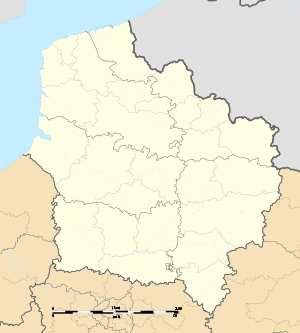Vaux-Marquenneville
Vaux-Marquenneville is a commune in the Somme department in Hauts-de-France in northern France.
Vaux-Marquenneville | |
|---|---|
 South face of the church, with the town hall behind | |
 Coat of arms | |
Location of Vaux-Marquenneville 
| |
 Vaux-Marquenneville  Vaux-Marquenneville | |
| Coordinates: 49°59′08″N 1°47′10″E | |
| Country | France |
| Region | Hauts-de-France |
| Department | Somme |
| Arrondissement | Abbeville |
| Canton | Gamaches |
| Intercommunality | CA Baie de Somme |
| Government | |
| • Mayor (2001–2008) | Paul Boutroy |
| Area 1 | 3.97 km2 (1.53 sq mi) |
| Population (2017-01-01)[1] | 87 |
| • Density | 22/km2 (57/sq mi) |
| Time zone | UTC+01:00 (CET) |
| • Summer (DST) | UTC+02:00 (CEST) |
| INSEE/Postal code | 80783 /80140 |
| Elevation | 70–122 m (230–400 ft) (avg. 152 m or 499 ft) |
| 1 French Land Register data, which excludes lakes, ponds, glaciers > 1 km2 (0.386 sq mi or 247 acres) and river estuaries. | |
Geography
The commune is situated 8 miles (13 km) south of Abbeville, on the D93 road. The name Vaux derives from ‘vale’ or ‘valley’ and Marquenneville comes from the domain of someone called Marca.[2] The inhabitants are known as ’’Vallois’’’
Population
| Year | 1936 | 1946 | 1954 | 1962 | 1968 | 1975 | 1982 | 1990 | 1999 | 2006 |
|---|---|---|---|---|---|---|---|---|---|---|
| Population | 117 | 83 | 98 | 74 | 78 | 75 | 62 | 72 | 67 | 78 |
| From the year 1962 on: No double counting—residents of multiple communes (e.g. students and military personnel) are counted only once. | ||||||||||
History
Known by many variants of the current name throughout the centuries: 1166: Vaux, 1557 Vaulx, 1757 Vaux 1284 Marquienvilla, 1301 Marchaigneville, 1312 Markaigneville, 1340 Markainneville, 1388 Marquenneville [3]
The Knights Templar were established nearby at Oisemont and had a farm at Vaux[4]
The first known seigneurs were the Riencourt family [4]
In 1790 the commune came under the management of the department of the Somme and in 1793 the town of Vaux was integrated into the arrondissement of Abbeville and the canton of Saint-Maxent.
1801 saw the neighbouring village of Marquenneville join with Vaux.[5]
The town was occupied, as were many French towns and villages, by the German army during World War II. In 1943 work began to build a V1 missile launch ramp at "Le Mont" in Marquenneville.
A German army deserter hid in a hangar under a pile of wheat and after fruitless search by the Wehrmacht, the soldier, with the help of the French Resistance escaped from France to Spain and return to his own home.
In June 1944. the V1 ramps were destroyed by No. 485 Squadron RNZAF. The bombardment lasted one and a half hours (from 15h45 to 17h15).
The village was liberated by a Canadian tank regiment in 1944.
Vaux-Marquenneville received the Croix de guerre with Bronze Star from the Secretary of State for War who said: "This courageous village, badly damaged during the Second World War, was delivered by faith and hard work".
Places of interest
- The sixteenth century church.[6] The Riencourt family tomb is inside[4]
- The war memorial [7] is on the left of the entrance to the church graveyard.
- Church of Vaux-Marquenneville
- The war memorial
- A cross
- The manor[8] with a 17th-century dovecote.
- Another dovecote of the same period can be found at another farm in the village.[4]
- The school and mairie[9]
- 1834: The presbytery serves as a school and communal housing. The annual salary of the teacher was 200 francs.
- 1838-1855: Renovation of the school.
- 1861: Separation of boys and girls by a partition.
- 1873: Collapse of the west side and part of the roof.
- 1876: Introduction of the municipal library in the school.
- 1883: Establishment of the Fund Schools.
- 1889-1890: Construction of the new mixed school (now the mairie).
- Since the 1960s, the school has been closed but the building is still used as the mairie.[10]
See also
References
- "Populations légales 2017". INSEE. Retrieved 6 January 2020.
- Source: "Les lieudits" de la Section Patrimoine CIS N°9
- Source: C.I.S.Section Patrimoine N°9
- Source: " la Somme, les 783 communes", septembre 2004, aux éditions Delattre, Grandvilliers (60)
- Fusion, source Cassini
- Histoire de Cloches
- Source: Mémorial morts pour la france (80) Archived 2008-07-03 at the Wayback Machine
- Sources:Quid
- Source: Section Patrimoine C.I.S. N°11 Pg:garde, 19, 29, 32, 52, 56
- Annuaire Mairie
External links
| Wikimedia Commons has media related to Vaux-Marquenneville. |
- Vaux-Marquenneville on the Quid website (in French)
- Friends of the CIS of Hallencourt (in French)